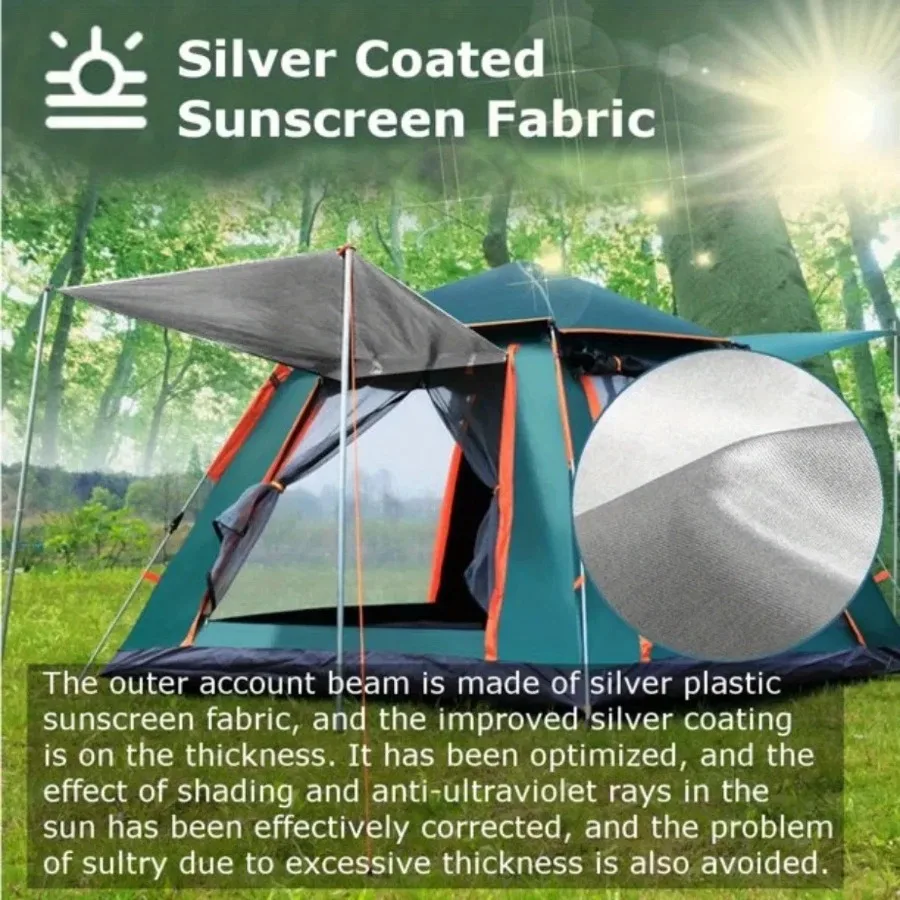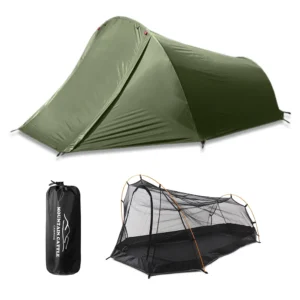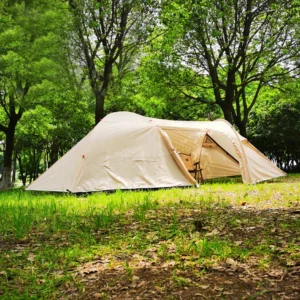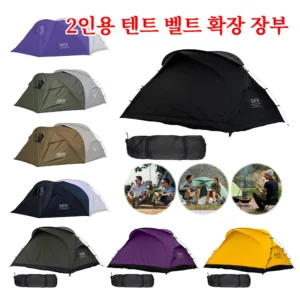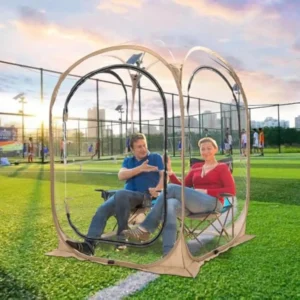The Science Behind Dome Tent Stability
When you step into the wilderness, your tent becomes your home—your shield against nature’s elements. Dome tents have revolutionized outdoor shelters with their remarkable stability, but what makes them so reliable?
At their core, dome tents rely on three fundamental principles:
– Triangulation: The geometric strength of triangular shapes
– Pole structure: Flexible poles that create arches and intersections
– Tension dynamics: The balanced distribution of force across the fabric
These engineering principles work together to create a structure that can withstand wind, rain, and even snow loads. Different dome tent designs—from basic two-pole structures to complex geodesic domes—offer varying levels of stability depending on their intended use.
The stability of a dome tent isn’t just about staying upright—it affects everything from sleep quality to safety in adverse weather conditions. Understanding these principles helps you make informed decisions when selecting a tent for your specific needs.
Modern ultimate guide dome tents two people provide excellent examples of how these engineering principles translate into practical, reliable shelters. The evolution from traditional A-frame tents to domes represents one of the most significant advances in camping shelter design, with stability being the primary benefit.
Learning about dome tent structure gives you insight into why these shelters perform so well in various environments and weather conditions.
Understanding Dome Tent Architecture
A dome tent’s architecture is deceptively simple yet remarkably effective. Each component plays a vital role in creating a structure that balances strength, weight, and packability.
The basic components include:
– Flexible poles that create arches and intersections
– Fabric that stretches across the frame
– Guy lines that provide additional tension and stability
– Stakes that secure the structure to the ground
These elements work together through principles borrowed from architectural engineering. The dome shape itself draws inspiration from nature—like the strength of an egg, which can withstand remarkable pressure despite its thin shell. This occurs because curved surfaces distribute force across the entire structure rather than concentrating it in one area.
Triangulation is particularly important in dome tents. When poles cross and form triangles, they create incredibly stable structures that resist deformation. Each additional crossing point adds strength to the overall design, which is why geodesic domes with multiple crossings can withstand extreme conditions.
The tension in the fabric also contributes significantly to stability. When properly pitched, the fabric pulls evenly in all directions, creating a balanced system where forces counteract each other. This tension, combined with the flexible strength of the poles, gives dome tents their characteristic resilience.
Our dome camping tent collection demonstrates these architectural principles in action, with designs that prioritize structural integrity in various conditions.
Pole Configuration: The Framework of Stability
Pole configuration is the backbone of dome tent stability. The number, diameter, material, and arrangement of poles directly affect how your tent performs when challenged by wind or snow.
Pole Materials and Their Properties:
– Aluminum: Excellent strength-to-weight ratio, durable, and maintains flexibility in cold weather
– Fiberglass: More affordable but heavier and less durable in extreme conditions
– Carbon fiber: Ultra-lightweight and strong but more expensive and sometimes brittle
Pole diameter significantly impacts strength—typically ranging from 8.5mm to 11mm for most recreational domes, with larger diameters offering greater stability in extreme conditions.
The way poles connect to the tent body also matters. Sleeve systems distribute tension more evenly but can be difficult to thread when wet or in windy conditions. Clip systems are easier to set up but may create more stress points. Hub-based systems offer excellent strength but add weight and complexity.
Pole geometry—the way poles arc and intersect—determines how weight and external pressure are distributed. More crossing points mean better distribution of forces and enhanced stability. This is why geodesic designs with 5+ pole crossings can withstand hurricane-force winds when properly anchored.
Understanding tent poles interchangeable systems can be helpful when considering repairs or modifications to enhance your tent’s stability.
Fabric Tension and Anchor Systems
Proper tensioning transforms a floppy assembly of fabric and poles into a sturdy shelter. Even the most sophisticated pole structure will fail if the fabric isn’t properly tensioned and anchored.
Guy lines are critical for maximizing stability. When properly deployed at approximately 45° angles from the tent, they create outward and downward forces that counter wind pressure. Most dome tents include multiple guy points, but many campers make the mistake of not using them in fair weather—leaving them unprepared when conditions change.
Staking technique significantly impacts stability:
– Use stakes appropriate for your terrain (sand, rocky soil, snow)
– Drive stakes at a 45° angle away from the tent
– Ensure even tension around the entire perimeter
– Consider using extra-long stakes for improved holding power
The fabric itself plays a crucial role in structural performance. Tightly woven, high-denier materials resist stretching when wet, maintaining tension throughout changing weather conditions. Silicone-treated fabrics typically hold their shape better than polyurethane-coated alternatives, contributing to long-term stability.
Creating symmetrical tension around the entire tent is essential—a loose corner can create a weak point that compromises the entire structure. Take time during setup to adjust all tension points evenly.
Our waterproof camping tent options feature carefully designed tensioning systems that maintain stability even during heavy rainfall.
Classic Dome Tent Shape: The Two-Pole Design
The classic two-pole dome is where it all began—the design that revolutionized camping shelters. This simple structure features two flexible poles that cross at the center to create an X-shaped framework over which the tent fabric stretches.
Stability Characteristics:
– Wind resistance typically up to 30-40 mph (48-64 km/h)
– Good performance in light rain and mild conditions
– Limited stability in heavy snow loads
– Moderate resistance to side winds
– Vulnerability to lifting in strong gusts
Pros:
– Simple and quick setup
– Lightweight and packable
– Affordable price point
– Adequate stability for most recreational camping
– Easy to repair in the field
Cons:
– Limited extreme weather performance
– Less headroom compared to more complex designs
– More prone to pole failure in high winds
– Requires careful staking and guy line usage
Basic dome tents shine in casual camping scenarios—weekend trips to established campgrounds, summer family camping, and situations where extreme weather isn’t expected. They provide an excellent balance of simplicity and function for most recreational campers.
To improve a basic dome’s stability, focus on proper staking, using all provided guy lines, and positioning the tent with its lowest profile facing the prevailing wind. These simple modifications can significantly enhance performance.
The advantages two-person dome tents make this classic design particularly popular for couples and solo campers who value simplicity and efficiency.
Modified Dome Designs: Extended and Hybrid Structures
Modified dome designs take the basic dome concept and enhance it with additional poles or structural elements to increase stability or usable space. These adaptations create versatile options that balance the simplicity of basic domes with improved performance.
Common Modifications Include:
– Extended vestibules supported by additional poles
– Ridge poles that increase interior height and stability
– Dome-tunnel hybrids with cylindrical extensions
– Additional crossing poles to reinforce the basic structure
– External pole systems that create more interior space
Extended dome designs offer significantly improved stability in one direction but may be weaker when wind hits from the side. This directional stability makes them ideal for predictable conditions but less versatile than true geodesic designs.
Adding height to a dome tent creates more comfortable living space but can reduce stability by catching more wind. Manufacturers often compensate with additional guy points or reinforced pole sections.
Dome-tunnel hybrids combine the stability of a dome for sleeping areas with the spacious living area of a tunnel design. These tents are popular for longer camping trips where comfort becomes more important, but they require careful orientation relative to wind direction.
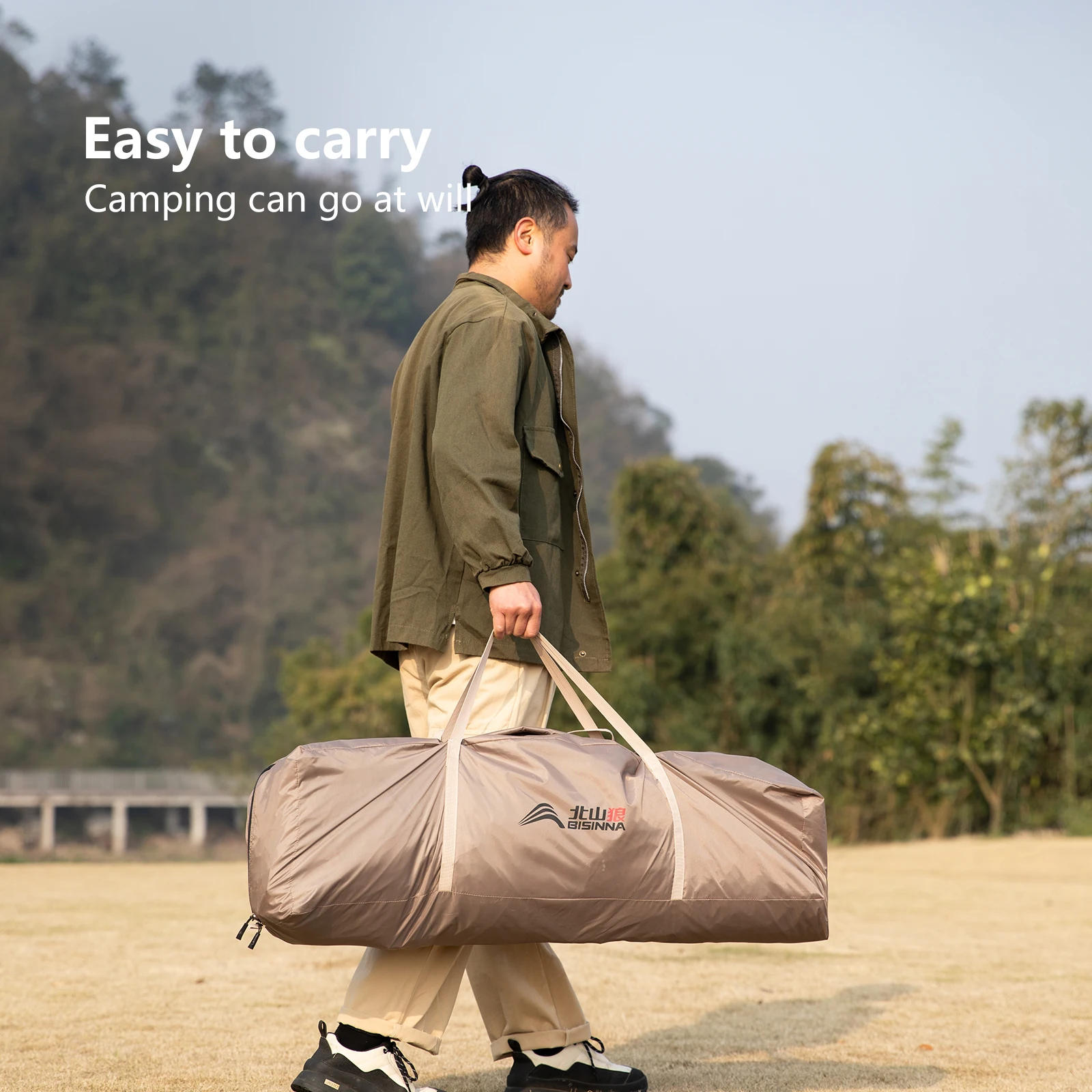
Our collection of camping tent vestibule designs showcases how these modified structures enhance both stability and functionality.
Semi-Geodesic Domes: Enhanced Performance
Semi-geodesic domes represent a significant step up in stability from basic dome designs. With 3-4 poles creating multiple crossing points, these tents offer substantially improved performance in challenging conditions without the weight and complexity of full geodesic structures.
Key Stability Features:
– Multiple pole crossings creating stronger triangulation
– Enhanced wind resistance (40-60 mph / 64-97 km/h)
– Better snow load capacity than basic domes
– Improved stability in uneven terrain
– More attachment points for guy lines
The additional pole crossing points in semi-geodesic designs create more triangular sections, which distribute external pressures more effectively across the entire structure. This enhanced load distribution makes these tents significantly more stable in strong winds and moderate snow loads.
Semi-geodesic domes excel in mountainous environments and weather-variable conditions where basic domes might struggle but full geodesic designs would be overkill. They offer an excellent balance of stability and weight, making them popular for backpacking in areas with unpredictable weather.
The pole configuration of semi-geodesic tents also improves their snow-shedding capabilities. The additional angles help prevent snow accumulation, reducing the risk of collapse under heavy loads.
Understanding tent shapes effective snow shedding capabilities becomes crucial when camping in winter or high-altitude environments where unexpected snowfall is possible.
Geodesic Domes: Maximum Stability in Extreme Conditions
True geodesic dome tents represent the pinnacle of tent stability engineering. With five or more poles creating multiple intersection points, these structures can withstand the most extreme weather conditions nature offers.
The term “geodesic” refers to the shortest line between two points on a curved surface. In tent design, this translates to multiple poles following optimal structural paths across the dome surface. These paths create numerous triangular segments that distribute forces with remarkable efficiency.
In geodesic domes, external pressure from wind or snow load is distributed across the entire structure rather than concentrated in specific areas. This even distribution prevents the catastrophic failure points that can occur in simpler designs.
Key stability characteristics include:
– Wind resistance exceeding 60 mph (97+ km/h)
– Excellent snow load capacity
– Minimal fabric flutter in high winds
– Self-supporting structure even before staking
– Stability from multiple directions (non-directional)
These tents excel in extreme alpine conditions, expedition base camps, and environments where tent failure could be life-threatening. Their ability to withstand sustained high winds and heavy snow loads makes them the standard for serious mountaineering and polar expeditions.
The trade-off for this exceptional stability is increased weight, complexity, and cost. Geodesic domes typically require more time to set up and use more materials than simpler designs, resulting in heavier packs and higher price points.
Our heavy duty 4 season tent collection includes geodesic models designed specifically for extreme weather stability.
Dome Tent Aerodynamics: Wind Performance Analysis
Wind represents one of the greatest challenges to tent stability, and dome shapes handle this challenge better than most other designs. Understanding how wind interacts with dome tents can help you select the right model and properly position it for maximum stability.
Wind Direction Impacts:
– Head-on wind: Domes excel due to their curved front profile that allows air to flow over and around
– Side wind: Performance varies by design—geodesic models resist better than basic domes due to more support points
– Variable/gusting winds: Multiple pole crossings provide resistance from multiple directions
– Updrafts: Lower profiles and proper staking prevent lifting
The height and profile of a dome tent significantly impact its wind performance. Lower-profile domes catch less wind but offer reduced interior space. Taller designs provide more livable space but create larger surfaces for wind to push against.
Wind tunnel testing has shown that true geodesic designs maintain their structural integrity in winds exceeding 60 mph, while basic two-pole domes may begin to deform significantly at 30-40 mph. This dramatic difference explains why design matters so much for high-wind environments.
The aerodynamic shape of dome tents—with no flat surfaces facing the wind—naturally channels air around the structure rather than allowing it to push directly against flat walls. This inherent advantage makes even basic domes more wind-resistant than many other tent designs.
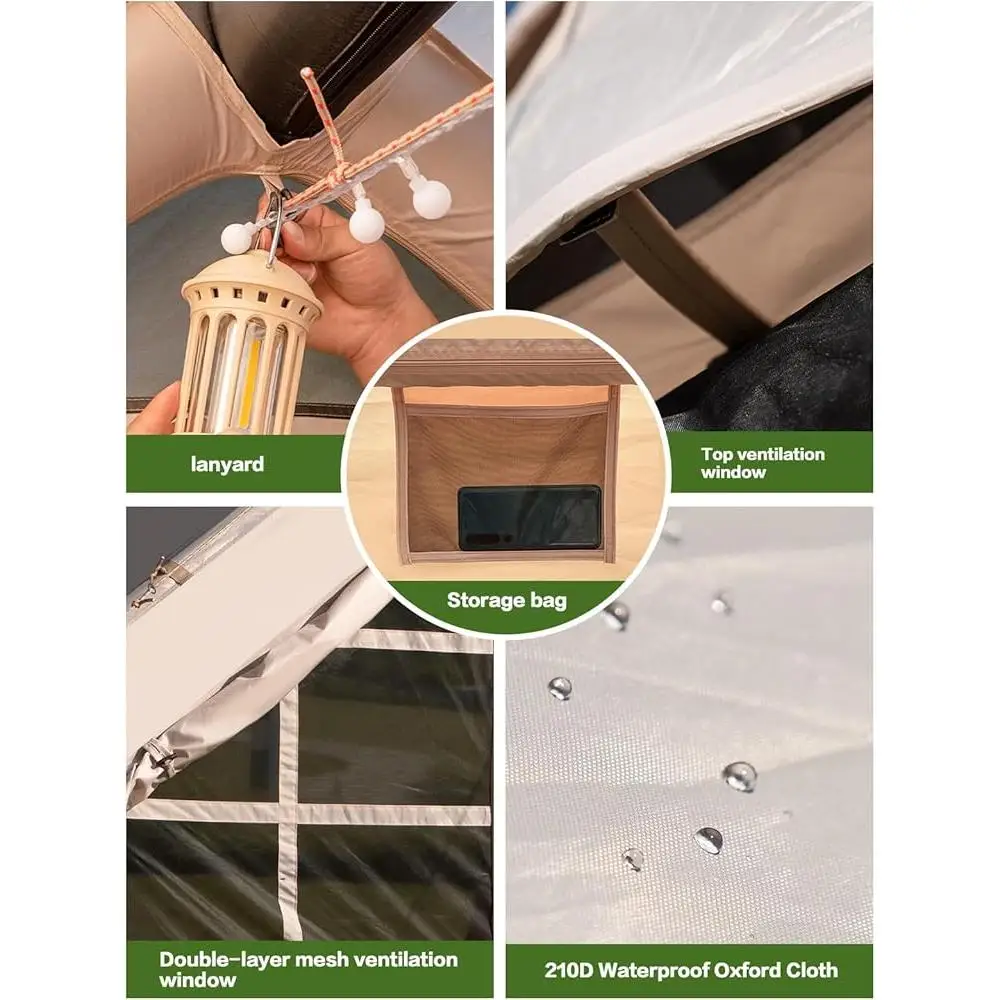
The principles of mastering wind stability freestanding tent design apply particularly well to dome structures, which naturally incorporate many aerodynamic features.
Maximizing Dome Tent Stability: Setup Techniques
Even the most advanced dome tent design can fail if improperly pitched. Mastering proper setup techniques dramatically improves stability in challenging conditions.
Site Selection Guidelines:
1. Choose level ground whenever possible
2. Avoid depressions where water might collect
3. Consider wind direction and select natural windbreaks
4. Clear the area of sharp objects that might damage the tent floor
5. Position the tent’s lowest profile toward prevailing winds
Proper Staking Sequence:
1. Stake opposing corners first to create proper tension
2. Complete the perimeter with even tension all around
3. Add remaining stakes working from the center outward
4. Adjust as needed to create symmetrical tension
Guy lines dramatically improve stability but are often overlooked in fair weather. Use taut-line hitches or trucker’s hitches to create adjustable tension, and position lines at 45° angles for optimal performance. Remember that dark-colored guy lines can be trip hazards—consider reflective cord for safety.
Regular maintenance preserves structural integrity over time. Inspect poles for microcracks, clean dirt from pole sections before storage, and store tents completely dry to prevent weakening of materials.
For those seeking lightweight options that don’t compromise on stability, our best 2 person dome tents hiking collection offers excellent balance between weight and performance.
Weather-Specific Stability Considerations
Different weather conditions require specific adaptations to maximize tent stability and performance.
High Wind Techniques:
– Orient the tent with its lowest, most aerodynamic profile facing the wind
– Use all guy points, even those that seem redundant in calm conditions
– Double-stake critical anchor points
– Consider adding rocks to stake loops for extra security
– Reduce pole flex by placing slight inward pressure during setup
Snow Load Management:
– Tap tent walls periodically to prevent snow accumulation
– Select geodesic or semi-geodesic designs for expected heavy snow
– Increase guy line tension as snow begins to fall
– Consider using snow stakes or buried objects as anchors
– Maintain symmetrical loading to prevent structural failure
Rain Considerations:
– Ensure proper fly tension to prevent contact with inner tent
– Create drainage channels away from tent entrances
– Adjust guy lines to compensate for stretching when fabrics become wet
– Consider additional waterproofing at seams for aging tents
Terrain Adaptations:
– On sand or snow, use specialized stakes or buried anchors
– On rocky ground, use rocks to reinforce stake points
– On slopes, orient the tent to prevent sliding and water entry
Our waterproof pop-up tent options offer quick deployment while maintaining reasonable stability in adverse weather conditions.
Comparative Analysis: Dome Tents vs. Other Tent Designs
While dome tents excel in many environments, understanding how they compare to other designs helps you select the right shelter for your specific needs.
| Tent Design | Stability Strengths | Stability Limitations | Best Applications |
|---|---|---|---|
| Dome | All-around stability, wind resistance, snow load capacity | Height can catch wind, footprint requires flat area | General camping, moderate to severe weather |
| Tunnel | Excellent directional stability, good space-to-weight ratio | Poor performance in crosswinds, requires careful orientation | Backpacking, predictable wind conditions |
| Cabin | Vertical walls, spacious interior | Poor wind resistance, weak in snow loading | Car camping, fair weather, family camping |
| A-Frame | Simple design, sheds snow well | Limited interior space, vulnerable to side winds | Basic backpacking, sheltered campsites |
| Pyramid | Excellent snow shedding, wind resistant | Center pole limits space, typically requires trekking poles | Alpine environments, snow camping |
Dome tents generally offer the best balance of livable space to stability but at the cost of added weight compared to more minimalist designs. Geodesic domes have the highest strength-to-weight ratio of any freestanding tent design, making them the standard for extreme conditions.
Directional stability varies significantly—tunnel tents perform exceptionally well when oriented properly but fail catastrophically when wind direction changes. Domes provide more consistent performance regardless of wind direction, especially geodesic models.
Our pop-up dome tent collection offers convenient setup while retaining many of the stability advantages inherent to dome designs.
How Do You Choose? Matching Dome Shape to Your Needs
Selecting the right dome tent involves matching design characteristics to your specific needs, considering where and when you’ll be camping.
For Weekend Campers in Fair Weather:
Basic two-pole dome tents offer sufficient stability with simple setup and affordable price points. Focus on comfort features rather than extreme weather performance.
For Backpackers Covering Long Distances:
Semi-geodesic designs balance weight and stability. Look for aluminum poles and minimal but strategic guy points to save weight without compromising essential stability.
For Alpine and Winter Camping:
True geodesic designs with at least 5 pole crossings provide necessary stability for high winds and snow loads. The weight penalty is justified by safety in extreme conditions.
For Family Camping:
Modified dome designs with extended vestibules or hybrid dome-tunnel configurations offer enhanced living space while maintaining good stability in moderate conditions.
For Budget-Conscious Campers:
Basic dome designs with fiberglass poles are affordable starting points. Improve stability through careful site selection and proper setup techniques rather than expensive upgrades.

Understanding the dome tent capacity guide helps ensure you select a tent with appropriate space for your group while maintaining stability.
Heavy Duty 4 Season Tent, Mountaineering Tent, Winter Camping Tent
$870.40 Select options This product has multiple variants. The options may be chosen on the product pageCompact Backpacking Tent, Lightweight Backpacking Tent, Waterproof Camping Tent
$335.52 Select options This product has multiple variants. The options may be chosen on the product pageCamping Tent with Vestibule, Waterproof Camping Tent
Price range: $407.89 through $479.48 Select options This product has multiple variants. The options may be chosen on the product pageHeavy Duty 4 Season Tent, Ultralight Freestanding Tent, Winter Camping Tent
$3,722.66 Select options This product has multiple variants. The options may be chosen on the product pageBackpacking Tent with Vestibule, Trekking Pole Backpacking Tent, Waterproof Camping Tent
Price range: $271.99 through $519.52 Select options This product has multiple variants. The options may be chosen on the product page
Will a Dome Tent Meet Your Stability Requirements?
While dome tents offer excellent stability overall, they’re not perfect for every situation. Understanding potential limitations helps you make informed decisions.
Potential Weaknesses to Consider:
– Basic domes may struggle in sustained high winds (over 30 mph/48 kmh)
– Larger dome tents catch more wind and may require additional guying
– Lower-quality poles can fail at stress points in challenging conditions
– Wet fabric stretches, requiring adjustment to maintain proper tension
– Extreme temperatures can affect pole flexibility and overall performance
Budget considerations inevitably impact stability. Entry-level dome tents ($50-150) provide adequate stability for casual camping but utilize lighter materials that compromise performance. Mid-range options ($150-350) offer significant improvements in stability through better materials and design. Premium expedition tents ($350+) provide maximum stability with specialized materials and construction techniques.
Regular maintenance significantly impacts long-term stability. Proper cleaning, drying, and storage extend the structural integrity of your tent, while UV exposure, improper storage, and failure to repair minor damage can compromise even well-designed domes.
The four season tent features benefits guide explains important considerations for those camping year-round in varying conditions.
Frequently Asked Questions About Dome Tent Stability
Are geodesic dome tents worth the extra cost?
For casual camping in mild conditions, probably not. For backcountry expeditions, alpine environments, or winter camping, absolutely. The enhanced stability can be critical in challenging conditions where tent failure isn’t just inconvenient but potentially dangerous.
How many poles indicate a stable dome tent?
More poles generally mean better stability, but design matters more than quantity. A well-designed 3-pole semi-geodesic tent may outperform a poorly designed 5-pole tent. Look for multiple crossing points rather than simply counting poles.
Which dome shape performs best in high winds?
True geodesic domes with 5+ intersection points provide the best wind performance from all directions. For directional winds, even semi-geodesic designs perform exceptionally well when properly oriented with their lowest profile facing the wind.
Can I improve my basic dome tent’s stability?
Absolutely! Use all provided guy lines, stake appropriately for your terrain, orient the tent correctly relative to wind direction, and consider adding aftermarket guy lines to reinforcement points. These simple steps significantly enhance stability.
How does snow load affect different dome designs?
Basic domes struggle with heavy snow loads, while geodesic designs excel. The difference lies in how forces distribute across the structure. Geodesic domes spread weight evenly across multiple intersection points, preventing localized failure that occurs in simpler designs.
What are the most critical maintenance points for maintaining dome tent stability?
Regularly inspect poles for microcracks or corrosion, clean dirt from pole segments before storage, ensure the tent is completely dry before long-term storage, repair small fabric tears immediately, and replace worn guy lines. These maintenance practices significantly extend the structural integrity of your tent.
At Explore Elements, we understand that stability directly impacts your outdoor experience. Our carefully selected dome tents balance innovative engineering with practical functionality to provide reliable shelter in diverse environments.

